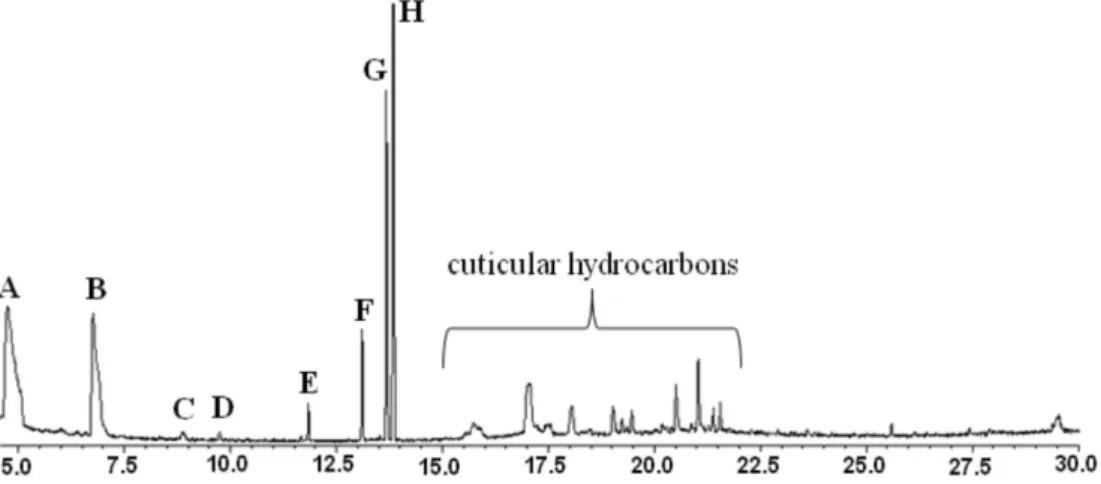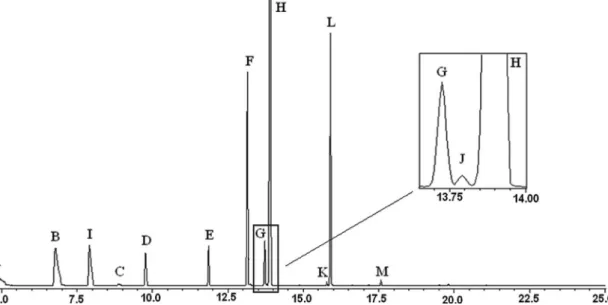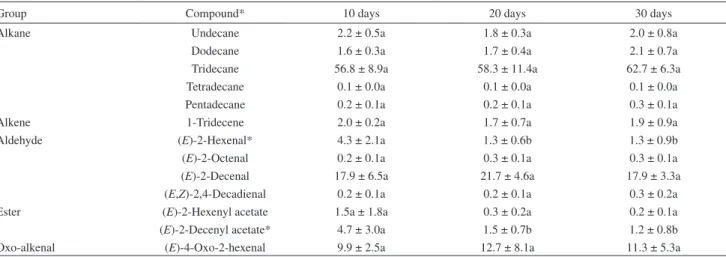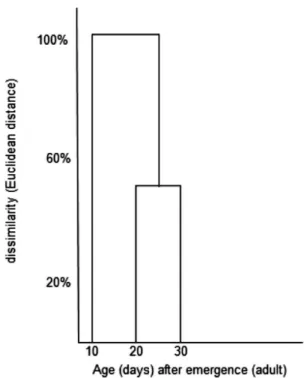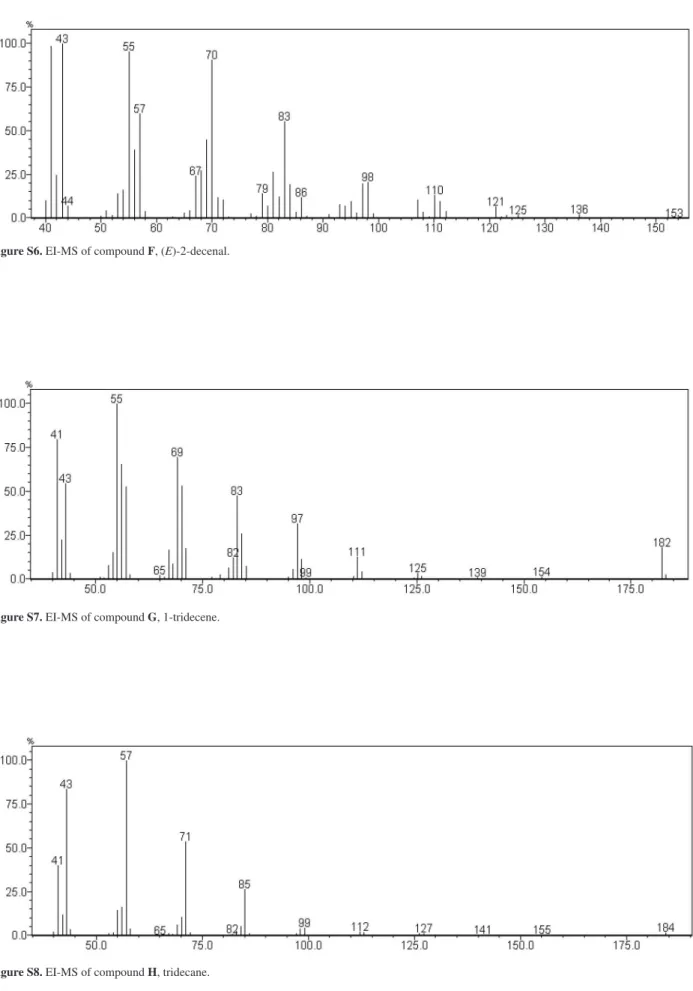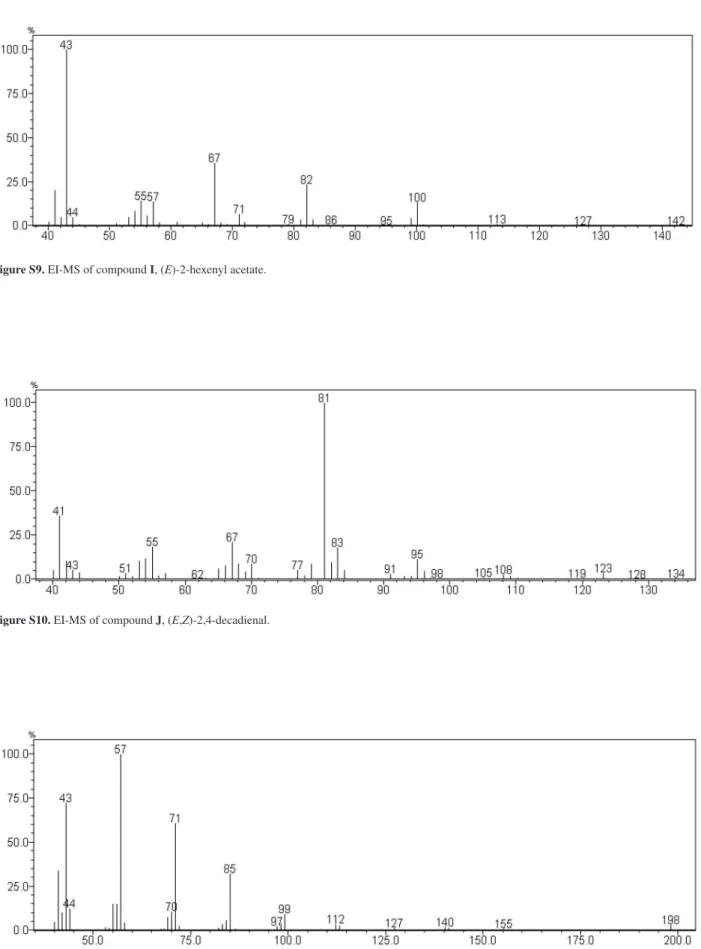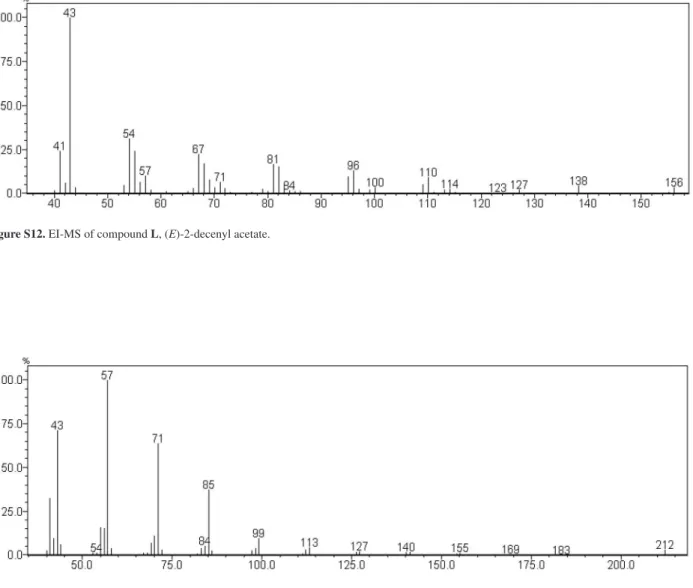Article
J. Braz. Chem. Soc., Vol. 22, No. 1, 58-64, 2011. Printed in Brazil - ©2011 Sociedade Brasileira de Química 0103 - 5053 $6.00+0.00
A
*e-mail: pzarbin@quimica.ufpr.br
Identiication of Semiochemicals in Adults and Nymphs of the Stink Bug
Pallantia
macunaima
Grazia (Hemiptera: Pentatomidae)
Carla F. Fávaro,a Mauro A.C. de M. Rodrigues,a Jeffrey R. Aldrichb and
Paulo H.G. Zarbin*,a
aDepartamento de Química, Universidade Federal do Paraná, CP 19081,
81531-980 Curitiba-PR, Brazil
bUSDA-ARS Invasive Insect Biocontrol & Behavior Laboratory, 10300 Baltimore Avenue, Bldg. 007,
rm301, BARC-West, Beltsville, MD 20705, USA
O conteúdo das glândulas abdominais dorsais em ninfas e das glândulas metatorácicas em machos e fêmeas (10, 20 e 30 dias de idade adulta) foi caracterizado e quantiicado para o percevejo Pallantia macunaima. O principal componente encontrado nas ninfas e adultos foi o tridecano, com menores quantidades de outros hidrocarbonetos alifáticos, aldeídos, oxo-alcenais e ésteres. Os cinco ínstares apresentaram diferenças signiicativas nas proporções dos compostos encontrados, principalmente entre aqueles do primeiro ínstar em relação aos demais ínstares. Nenhuma diferença signiicativa foi detectada na proporção dos compostos das glândulas metatorácicas entre os machos e fêmeas, porém, entre indivíduos de diferentes idades, (E)-2-hexenal e acetato de (E)-2-decenila diminuiram signiicativamente de 10 para 20 dias de idade.
The contents of the dorsal abdominal glands in nymphs and the metathoracic glands in adult males and females (10, 20 and 30 days old) were characterized and quantiied for the stink bug, Pallantia macunaima. The major component for nymphs and adults was tridecane, with lesser amounts of other aliphatic hydrocarbons, aldehydes, oxo-alkenals and esters. The ive nymphal instars showed signiicant differences in the proportions of compounds present, mainly between those of the irst instar compared to the dorsal abdominal glands components of later instars. No signiicant differences were detected in the proportion of metathoracic gland components between the sexes but, between individuals of different ages, (E)-2-hexenal and (E)-2-decenyl acetate signiicantly decreased in adults from 10 to 20 days of age.
Keywords: allomone, pheromone, gland, hemiptera, Pallantia macunaima
Introduction
Stink bugs (Heteroptera: Pentatomidae) are among the main agricultural pests in the world, and they are increasingly important with the advent of genetically modiied crops.1 The piercing-sucking mode of feeding
exhibited by stink bugs is particularly damaging to maturing fruit and seeds, and stink bugs often migrate undetected into maturing crops from wild hosts plants or other crops.2 Pallantia macunaima is one of the important heteropteran pests found in southern Brazil.1 New methods are needed
to minimize or eliminate application of environmentally harmful insecticides used to control this stink bug, as well as other pest species.
Pheromones are potentially useful for monitoring and otherwise managing pest species, and signiicant progress has been made in the identification of the pheromones of Heteroptera3 since the irst heteropteran
pheromone was identiied.4 However, the identiication
of heteropteran pheromones is complicated by the fact that these so-called “true bugs” characteristically produce large quantities of strong-smelling and irritating defensive chemicals (allomones), which are released when the bugs are disturbed.5 This mixture of chemical compounds
frequently serves as both an alarm pheromone and as an allomone for defense against predators.5 Heteropteran
Fávaro et al. 59 Vol. 22, No. 1, 2011
for identiication.6 In some species, the DAG secretions
of nymphs act as aggregation pheromones or arrestants; for example, (E)-4-oxo-2-decenal is characteristic of irst-instar nymphs6 and serves as an aggregation pheromone.7,8
In adults, allomones are produced in the metathoracic scent gland (MTG). Identiication of MTG secretions has received considerable attention, in part, because these secretions constitute such an obvious defense, and the components are simple compounds produced in comparatively large quantities making them easy to analyze and identify.5,9 The compositions of stink bug
allomones are similar for most species, including normal hydrocarbons, plus saturated and unsaturated aldehydes and esters.5
The main purpose of the present work was (i) to identify and quantitate the chemical composition of the exuviae for the ive nymphal instars and, (ii) to identify the chemical components of the MTG secretion for P. macunaima adults and, (iii) to compare the composition of the secretions from males and females of differing ages (10, 20 and 30 days post-emergence).
Experimental
Insects
A colony of P. macunaima was started from bugs provided by Dr. A. R. Panizzi (EMBRAPA Soja, Londrina, Paraná, Brazil).The bugs were reared on soybean seeds (Glycine max), green beans (Phaseolus vulgaris), peanuts (Arachis hypogaea), and glossy privet (Ligustrum lucidum) at 26 ± 2 ºC, 70% relative humidity, and a 14:10 h light-dark cycle.
Extraction of dorsal abdominal glands contents
Hexane extracts of the DAGs for the ive instars were prepared by extracting exuviae collected ≤ 24 h after ecdysis. Ten exuviae were extracted for each sample of irst instars, 8 for second instars, 6 for third instars, 5 for fourth instars, and 3 for ifth instars. Exuviae were extracted for 24 h, after which the hexane extract was transferred to another clean vial and stored in a freezer −20 ºC until analysis. Three extracts were prepared and analyzed for each nymphal instar.
Extraction of metathoracic gland secretion
An adult P. macunaima was pinned dorsal-side-up through the prothorax in a Petri dish, and submerged in tap water. The dissection process (using small surgical
scissors and sharpened forceps) consisted of removing the wings, cutting the lateral margins of the abdomen anteriorly up to the metathorax, and transversely cutting the anterior margin of the scutellum. The tergal cuticle was pulled back, and the viscera were removed. The scent gland complex, located in the ventral metathoracic region, could then be reached and removed by cutting laterally through the meso- and metathorax, turning the preparation over, and cutting transversely between the meta and prothorax. The gland reservoir, including the lateral accessory glands,10 was removed, dried with tissue
paper, immersed in 200 µL of analytical grade hexane, and stored at −20 ºC until analysis. Five MTG extracts were prepared for each sex and age (10, 20 and 30 days post-emergence).
Chemical analyses
Extracts were analyzed (1 µL of extract) by coupled gas chromatography-mass spectrometry (GC-MS) using a Shimadzu QP-5050A GC-MS operated in the electron impact ionization mode (70 eV), and equipped with a DB-5 capillary column (30 m × 0.25 mm i.d. × 0.25 µm; J & W Scientiic, Folsom, California, USA). The GC was operated in the splitless mode, programming the temperature from 50 ºC for 1 min, then increasing at 7 ºC min-1 to 250 ºC,
and holding at this temperature for 10 min. The National Institute of Standards and Technology (NIST) mass spectral chemical database was used.
Chemical standards
(E)-2-Hexenal, (E)-2-octenal, (E)-2-decenal, (E,Z )-2,4-decadienal and (E)-2-decen-1-ol were purchased from Acros Organics (Geel, Turnhout, Belgium). Undecane, dodecane, tridecane, tetradecane, pentadecane, 1-tridecene and (E)-2-hexenyl acetate were purchased from Aldrich Chemical Company (Milwaukee, Wisconsin, USA).
(E)-4-oxo-2-Hexenal and (E)-4-oxo-2-decenal were gifts from Dr. K. Chauhan, USDA-ARS Beltsville, MD, USA,11 and Prof. Dr. J. G. Millar, University of California,
Riverside, CA, USA,12 respectively.
(E)-2-Decenyl acetate was prepared by allowing a mixture of (E)-2-decen-1-ol (1.1 g), acetic anhydride (1.1 g), triethylamine (1.5 mL), and 4-(dimethylamino)pyridine (0.075 g) to stand for 24 h at room temperature. Ether and 2 mol L-1 HCl were added, and the organic phase was
washed with saturated NaHCO3, dried over MgSO4, and the solvent evaporated in vacuo.8,9 The resulting product,
(E)-2-decenyl acetate [m/z 198 (M+, < 1%), 138 (M-60,
Statistical data analysis
Analysis of variance (ANOVA) followed by the Tukey test and variation analysis was used to compare the percentages of compounds present in extracts of exuviae and MTG. In addition, a cluster analysis was performed for the percentages of MTG compounds, and for using a Euclidean distance dissimilarity measure.13
Results and Discussion
A maximum of eight compounds were commonly found in the DAG secretions of P. macunaima nymphs (Figure 1). Mass spectral data suggested that compounds A and C-H were (E)-2-hexenal, (E)-2-octenal, undecane, dodecane, (E)-2-decenal, 1-tridecene, and tridecane, respectively. These identiications were conirmed by GC coinjection, and mass spectral comparisons with those of authentic standards. A matching mass spectrum for compound B was not found in the GC-MS database, but this compound exhibited characteristic ions at m/z (%) 112 (11),
97 (4), 83 (100) and 55 (78) (M+, CHOCHCHCOCH 2
+,
CHOCHCHCO+ and CHOCHCH+, respectively) matching
the spectrum for (E)-4-oxo-2-hexenal.14 The identity of
this compound in P. macunaima nymphs as (E )-4-oxo-2-hexenal was confirmed by GC coinjection with the authentic standard.11,12
The GC trace for the exuvial extract of irst-instar nymphs was signiicantly different from that for second- to ifth-instar nymphs according to analysis of variance, while the composition of exuvial extracts for second- to fifth-instars did not differ significantly (Table 1). Tridecane and (E)-4-oxo-2-hexenal are major components in irst instars, followed by lesser amounts of 1-tridecene and (E)-2-decenal. The major component from second instars is tridecane, followed by signiicant amounts of 1-tridecene, (E)-2-hexenal, (E)-2-decenal and (E )-4-oxo-2-hexenal, plus traces of undecane, dodecane and (E)-2-octenal.
Four compounds varied in relative abundances among the exuvial extracts analyzed for nymphs (Tables 1 and 2): dodecane, (E)-2-hexenal, (E)-2-decenal and (E
)-4-oxo-2-Figure 1. Gas chromatogram of exuviae extract from a ifth-instar P. macunaima nymph. Compounds: A: (E)-2-hexenal, B: (E)-4-oxo-2-hexenal, C: (E
)-2-octenal, D: undecane, E: dodecane, F: (E)-2-decenal, G: 1-tridecene, H: tridecane.
Table 1. Relative abundances (%) of compounds present in P. macunaima exuvial extracts of irst- to ifth-instar nymphs (mean ± SD) (n = 3)
Pallantia macunaima
Group Compound 1st 2nd 3rd 4th 5th
Alkane Undecane 0.0 ± 0.0a 0.1 ± 0.0a 0.2 ± 0.1a 0.3 ± 0.0a 0.7 ± 0.5a
Dodecane* 0.0 ± 0.0a 0.8 ± 0.2b 1.0 ± 0.1b 1.1 ± 0.2b 1.2 ± 0.1b
Tridecane 30.1 ± 2.0a 34.6 ± 2.5a 42.1 ± 4.3a 43.6 ± 3.4a 35.4 ± 8.3a
Alkene 1-Tridecene 10.6 ± 1.0a 13.3 ± 1.2a 15.1 ± 0.1a 13.6 ± 1.6a 11.3 ± 2.3a
Fávaro et al. 61 Vol. 22, No. 1, 2011
hexenal, with the irst two compounds increasing and the last two decreasing in abundance in older nymphs.
The DAG secretion of irst-instar nymphs of some, but not all, pentatomid species previously analyzed contain (E)-4-oxo-2-decenal, which is totally absent in the secretions of later instars.6 This irst-instar characteristic compound
mediates aggregation.7,8 Interestingly, (E)-4-oxo-2-decenal
is not produced by irst-instars of P. macunaima (analyzed using a DB-WAX® polar column; data not shown), yet
the data presented herein show that the composition of the DAG secretion differs signiicantly from that of later instars. The distinguishing feature of the DAG secretion from irst-instar P. macunaima nymphs is the relatively much greater abundance of (E)-2-decenal and (E)-4-oxo-2-hexenal (Tables 1 and 2). Therefore, it is tempting to speculate that
these compounds serve as an aggregation pheromone for irst-instars of P. macunaima, which also form tight clusters for much of the duration of this stage, but proof of such a behavioral role awaits further research.
The metathoracic scent gland (MTG) of P. macunaima
adults is, as in other stink bugs, well developed with an orange colored reservoir that is easily recognized upon dissection. MTG extracts of males and females of this species were typical of other Pentatomidae.3 In addition
to the same compounds found in P. macunaima nymphs, adults also produced (E)-2-hexenyl acetate, (E)-2-decenyl acetate, (E,Z)-2,4-decadienal, tetradecane and pentadecane (Figure 2). These MTG secretory components exhibited mass spectra matching the spectra of the aforementioned compounds in the NIST computer database, and were
Table 2. Compounds present in exuvial extracts of P. macunaima nymphs, and variation analysis of the percent differences with age
Group Compound Analysisa Trend Changeb %c
Alkane Undecane ns 0.2
Dodecane ** 0.8
Tridecane ns 37.2
Alhene 1-Tridecane ns 12.8
Aldehyde (E)-2-Hexenal ** 19.9
(E)-2-Octenal ns 0.6
(E)-2-Decenal ** 12.4
Oxo-alkenal (E)-4-Oxo-2-hexenal ** 16.2
ans = not signiicant; **statistical tests indicates difference between the mean; bline formed by means of the treatments (irst- to ifth-instars); caverage of
all treatments.
Figure 2. Gas chromatogram of a metathoracic gland extract of a P. macunaima adult female 10 days-old. Compounds: A: (E)-2-hexenal, B: (E
conirmed by GC coinjection with synthetic standards. MTG extracts from adult males and females of the same age were qualitatively and quantitatively similar, with tridecane being the most abundant constituent of the blend (Table 3). However, we observed signiicant differences in the proportions of two compounds in the comparisons
between the different age groups; namely, (E)-2-hexenal and (E)-2-decenyl acetate, which each significantly decreased in adults from 10 to 20 days old (Table 4). There were no signiicant differences in the proportions of MTG compounds from 20 and 30 days of age, as shown in the dendrogram of the cluster analysis (Figure 3).
Table 3. Relative abundances (%) of compounds found in the metathoracic gland (MTG) extracts of P. macunaima adults (mean ± SD) (n = 5). Values
in % by MTG
Group Compound* 10 days 20 days 30 days
Alkane Undecane 2.2 ± 0.5a 1.8 ± 0.3a 2.0 ± 0.8a
Dodecane 1.6 ± 0.3a 1.7 ± 0.4a 2.1 ± 0.7a
Tridecane 56.8 ± 8.9a 58.3 ± 11.4a 62.7 ± 6.3a
Tetradecane 0.1 ± 0.0a 0.1 ± 0.0a 0.1 ± 0.0a
Pentadecane 0.2 ± 0.1a 0.2 ± 0.1a 0.3 ± 0.1a
Alkene 1-Tridecene 2.0 ± 0.2a 1.7 ± 0.7a 1.9 ± 0.9a
Aldehyde (E)-2-Hexenal* 4.3 ± 2.1a 1.3 ± 0.6b 1.3 ± 0.9b
(E)-2-Octenal 0.2 ± 0.1a 0.3 ± 0.1a 0.3 ± 0.1a
(E)-2-Decenal 17.9 ± 6.5a 21.7 ± 4.6a 17.9 ± 3.3a
(E,Z)-2,4-Decadienal 0.2 ± 0.1a 0.2 ± 0.1a 0.3 ± 0.2a
Ester (E)-2-Hexenyl acetate 1.5a ± 1.8a 0.3 ± 0.2a 0.2 ± 0.1a
(E)-2-Decenyl acetate* 4.7 ± 3.0a 1.5 ± 0.7b 1.2 ± 0.8b
Oxo-alkenal (E)-4-Oxo-2-hexenal 9.9 ± 2.5a 12.7 ± 8.1a 11.3 ± 5.3a
*Compounds that showed signiicant differences with age. Tukey test (p > 0.05).
Table 4. Relative abundances (%) of compounds present in MTG extracts of P. macunaima adults 10, 20 and 30 days old, and variation analysis of the
percent differences with age
Group Compound Analysisa Trend Changeb %c
Alkane Undecane ns 2
Dodecane ns 1.8
Tridecane ns 59.3
Tetradecane ns 0.1
Pentadecane ns 0.2
Alkene 1-Tridecene ns 1.9
Aldehyde 2-Hexenal ** 2.3
2-Octenal ns 0.3
2-Decenal ns 19.2
2,4-Decadienal ns 0.2
Ester (E)-2-Hexenyl acetate ns 0.7
(E)-2-Decenyl acetate ** 2.5
Oxo-alkenal 4-Oxo-2-hexenal ns 11.3
ans = not signiicant; **statistics test indicates difference between the mean; bline formed by means of the treatments (10, 20 and 30 days post-emergence
Fávaro et al. 63 Vol. 22, No. 1, 2011
Conclusions
Attractant pheromones are produced in and released from the MTGs of some Heteroptera,3 probably from the
lateral accessory glands attached to the MTG reservoir.15-17
MTG-derived attractant pheromones are either produced by males (in some Lygaeidae and Alydidae)15,16,18 or
females (Miridae, and some Alydidae),17,19-23 yet allomones
are also stored in and released from the MTG reservoir in these species.16,17,24 However, no sexual dimorphism
was observed for the MTG secretions of P. macunaima
adults. The reduction of (E)-2-decenyl acetate detected as a function of the age of Pallantia adults is consistent with the hypothesis that aliphatic aldehydes in the MTG reservoir are derived from the alcohol moiety of the corresponding esters in the lateral accessory glands of the MTG complex,10,25 although the decrease of (E)-2-hexenal
with age is inconsistent with this hypothesis. It is possible the differences in MTG chemistry are indicative of the age of bugs, and that this is possibly of ecological relevance, but requires further behavioral experimentation to demonstrate but, in any case, it seems unlikely that the MTG secretion in
P. macunaima is involved in sex or aggregation pheromone production. Rather, the presumed attractant pheromone of
P. macunaima is probably produced elsewhere, such as the abdominal sternum of males,26 as in other pentatomids.3
Figure 3. Dendrogram resulting from the analysis of different ages after
emergence to the adult stage of P. macunaima based on the percentage of the thirteen compounds present in the MTG (X-axis) with the Euclidean distance as similarity measurement (Y-axis). There are two distinct groups; the irst group consists of 10-days old adults (males and females), and the second group is a cluster of 20-days and 30-days old adults.
Research is currently underway to isolate and identify the attractant pheromone of P. macunaima.
Supplementary Information
Mass spectra from all the identiied compounds are available free of charge at http://jbcs.sbq.org.br, as a PDF ile.
Acknowledgments
We thank the INCT Semiochemicals and CAPES (Coordenação de Aperfeiçoamento de Pessoal de Nível Superior) for financial support, Dr. A. R. Panizzi for providing the irst insects, Drs. Chauhan and Millar for gifts of (E)-4-oxo-2-hexenal and (E)-4-oxo-2-decenal, respectively. We are also grateful to CNPq for funding the visit of Dr. Jeffrey R. Aldrich to the Federal University of Paraná (visiting researcher; proc.: 401604/2009-8).
References
1. Bundy, C. S.; McPherson, R. M.; J. Econ. Ent. 2000, 93, 697.
2. Tillman, P. G.; Aldrich, J. R.; Khrimian, A.; Cottrell, T. E.;
Environ. Entomol.2010, 39, 610.
3. Millar, J. G.; Topics in Current Chemistry:Pheromones of True Bugs, Springer-Verlag: Heidelberg, 2005, p. 139.
4. Aldrich, J. R.; Kochansky, J. P.; Abrams, C. B.; Environ. Entomol.1984, 13, 1031.
5. Aldrich, J. R.; Annu. Rev. Entomol.1988, 33, 211. 6. Borges, M.; Aldrich, J. R.; Experientia1992, 48, 893. 7. Pavis, C.; Malosse, C.; Ducrot, P. H.; Descoins, C.; J. Chem.
Ecol.1994, 20, 2213.
8. Fucarino, A.; Millar, J. G.; McElfresh, J. S.; Colazza, S.;
J. Chem. Ecol.2004, 30, 1257.
9. Ho, H.-Y.; Millar, J. G.; Zool. Stud.2001, 40, 6.
10. Aldrich, J. R.; Blum, M. S.; Hefetz, A.; Fales, H. M.; Lloyd, H. A.; Roller, P.; Science1978, 201, 452.
11. Feldlaufer, M. F.; Domingue, M. J.; Chauhan, K. R.; Aldrich, J. R.; J. Med. Entomol.2010, 47, 140.
12. Moreira, J. A.; Millar, J. G.; J. Chem. Ecol.2005, 31, 965. 13. Scott, A. J.; Knott, M. A.; Biometrics1974, 30, 6.
14. Krall , B. S.; Bartelt, R. J.; Lewis Cara, J.; Whitman, D. W.;
J. Chem. Ecol.1999, 25, 2477.
15. Aldrich, J. R.; Leal, W. S.; Nishida, R.; Khrimian, A. P.; Lee, C.-J.; Sakuratani, Y.; Entomol. Exp. Appl.1997, 84, 127. 16. Aldrich, J. R.; Oliver, J. E.; Taghizadeh, T.; Ferreira, J. T. B.;
Liewehr, D.; Chemoecol.1999, 9, 63.
17. Aldrich, J. R.; Zhang, A.; Oliver, J. E.; Can. Entomol.2000,
18. Leal, W. S.; Higuchi, H.; Mizutani, N.; Nakamori, H.; Kadosawa, T.; Ono, M.; J. Chem. Ecol.1995, 21, 973. 19. Smith, R. F.; Pierce Jr., H. D.; Borden, J. H.; J. Chem. Ecol.
1991, 17, 1437.
20. Leal, W. S.; Ueda, Y.; Ono, M.; J. Chem. Ecol.1996, 22, 1429. 21. Millar, J. G.; Rice, R. E.; Wang, Q.; J. Chem. Ecol.1997, 23,
1743.
22. Zhang, Q.-H.; Aldrich, J. R.; J. Chem. Ecol.2003, 29, 1835. 23. Zhang, Q.-H.; Aldrich, J. R.; J. Chem. Ecol.2008, 34, 719.
24. Leal, W. S.; Kadosawa, T.; Biosci., Biotechnol., Biochem.1992,
56, 1004.
25. Staddon, B. W.; Ann. Soc. Entomol. Fr.1986, 22, 183. 26. Cribb, B. W.; Siriwardana, K. N.; Walter, G. H.; J. Morphol.
2006, 267, 831.
Supplementary Information
J. Braz. Chem. Soc., Vol. 22, No. 1, S1-S5, 2011. Printed in Brazil - ©2011 Sociedade Brasileira de Química
0103 - 5053 $6.00+0.00
S
I
*e-mail: pzarbin@quimica.ufpr.br
Identiication of Semiochemicals in Adults and Nymphs of the Stink Bug
Pallantia
macunaima
Grazia (Hemiptera: Pentatomidae)
Carla F. Fávaro,a Mauro A.C. de M. Rodrigues,a Jeffrey R. Aldrichb and
Paulo H.G. Zarbin*,a
aDepartamento de Química, Universidade Federal do Paraná, CP 19081,
81531-980 Curitiba-PR, Brazil
bUSDA-ARS Invasive Insect Biocontrol & Behavior Laboratory, 10300 Baltimore Avenue, Bldg. 007,
rm301, BARC-West, Beltsville, MD 20705, USA
Figure S1. EI-MS of compound A, (E)-2-hexenal.
Figure S3. EI-MS of compound C, (E)-2-octenal.
Figure S4. EI-MS of compound D, undecane.
Fávaro et al. S3 Vol. 22, No. 1, 2011
Figure S6. EI-MS of compound F, (E)-2-decenal.
Figure S7. EI-MS of compound G, 1-tridecene.
Figure S11. EI-MS of compound K, tetradecane.
Figure S10. EI-MS of compound J, (E,Z)-2,4-decadienal.
Fávaro et al. S5 Vol. 22, No. 1, 2011
Figure S13. EI-MS of compound M, pentadecane.
